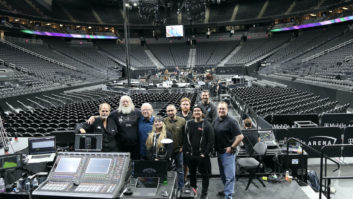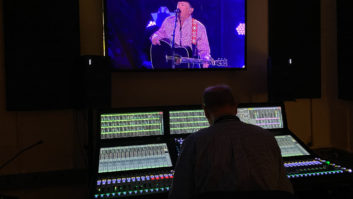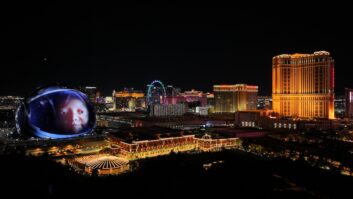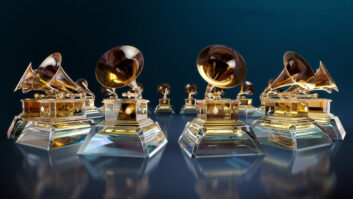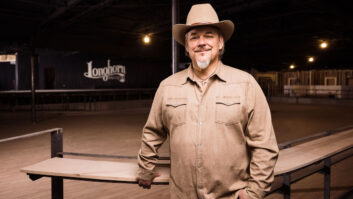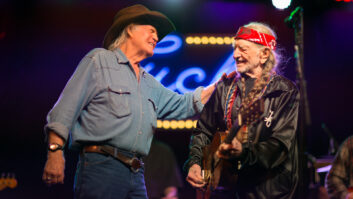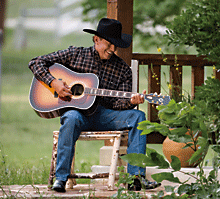
Strait Facts: George Strait has more Number One hit singles than any other recording artist. “I Saw God Today,” the first single from his new (and 37th) album, Troubadour, marked his 56th Number One hit, and the disc debuted at Number One on the Billboard 200 chart. Strait has sold more than 67 million records, garnering 32 Platinum or multi-Platinum certifications, second only to Elvis Presley. On April 1, 2008, XM Radio launched a new channel, Strait Country, dedicated exclusively to his music.
Tony Brown and Chuck Ainlay, Nashville legends themselves, have been producing and engineering Strait’s records since the 1992 soundtrack for Pure Country, in which he also starred. “I went to see George in Las Vegas,” Brown recalls. “Jimmy Bowen was producing George at the time. I’m backstage with [Strait’s longtime manager] Irv Woolsey, and holding court is Col. Tom Parker. He convinced George to do the movie. Then Bowen left Capitol, handed me the reins and Capitol gave me ‘six weeks to prepare to fail.’ As it turned out, the movie wasn’t big in theaters, but it was a hit on cable and rentals, every song in the movie was on the album and it sold 6 or 7 million copies.”
Ainlay, meanwhile, had been engineering for Bowen. “He kind of discovered me,” the engineer explains. “I was doing all the rock ‘n’ roll stuff in town and he found me through The Castle studio. I started mixing 80 percent of what he was doing, a lot of records every year. He did the second George Strait album and I was involved with the following one, and since then I’ve been involved with every record George has done. Now, I record, overdub and mix; I take on the entire project. At that time, I did overdubs or mixing. I was also working with Tony, basically everything he did, and when he took over as George’s producer, he brought me in. I recorded and mixed Pure Country. I’ve had a longstanding relationship with George, and he’s one of the very few that are loyal to the people around him. He will not do a session if he can’t get the people he wants.”
After 15 albums, Brown says the relationship hasn’t changed at all. “It’s so easy with him,” he says. “Cutting tracks is so much fun. The band is there; there’s a lot of interaction; we get vocals, background vocals and overdubs done; but when you mix you discover what’s really on the tracks, the subtle things. You scope out every musician’s part, and George’s vocals are always so good. He’s a great singer, like Sinatra.”
Troubadour, like its award-winning predecessor, It Just Comes Natural, was recorded in Key West, Fla., at Jimmy Buffett’s Shrimp Boat Sound studio. Brown says the area is conducive to Strait’s voice as — unlike in Nashville — allergies don’t flare. And there’s the setting: boardwalk, boats, pedestrians and bicycles. Band, artist and recording team could walk to and from the studio and their hotel and have meals together.
As producer, Brown’s work with Strait begins a year in advance as they look for songs. “Then we meet the day before we start tracking and every morning before we track, and a lot of times we discover what the record will be right before we go in,” Brown says. “When I start a George Strait record, it becomes my life for two months. The relationship between producer and artist has to be very close. He trusts me. I call the musicians he likes, I get the engineer he wants, he cuts where he wants. George doesn’t want to change anything and neither do I. It’s a comfort zone that works for both of us.”
It’s common in Nashville for studio musicians to cut tracks while an artist is on the road, with the vocalist flying in during tour breaks. Strait, however, cuts on-site with the musicians. “We want the whole band there,” says Brown. “They all play at once, and everyone inspires each other. It’s magic. It’s so much fun to watch them all playing. We usually cut in one week, everything except background vocals and strings. I bring it back to Nashville, work for a couple of weeks on his vocals, send them to him [in Texas] for approval, work on background vocals for four days, send those to him for approval, we mix for two weeks, he approves, we sequence the songs, master, he approves and we’re done.”
“We work really fast,” Ainlay adds. “You have to be able to capture the first take because it happens so quickly. The musicians are on it from the first note and he’s ready to go. He’s in the moment and that’s the best time to get him.
Working at Shrimp Boat Sound is a challenge because, as compared to Nashville studios, it’s about the size of a postage stamp. “It’s very, very confining,” Ainlay describes. “The control room is on an irregular slope, the console is in the wrong place, there’s very little isolation in the booth and not very good-sounding booths. It’s so restrictive that we used the truck that brought the equipment to Key West as a booth and put all the guitar and steel amps along the wall of the panel truck, baffled off the amps in the truck and miked them closely.
“There’s another small booth in the studio that I think was originally intended for drums,” Ainlay continues. “There’s no way it could sound good, so I put the drums on the floor, acoustic guitars in the room and we have had three musicians in that room at one time, and a small room with the fiddle player in it. The studio has one room and two small booths. George is in the small booth outside of the control room and he can see us and the musicians. The main room has a piano that we blanket heavily to keep the drums out of those mics; we have a synth, a B3, drums, and then the bass player and two electric guitar players are in the room. The bass we take direct, guitars in the truck, and that’s the lineup. We have to turn all the air conditioners off because they’re so noisy, so that gives the musicians incentive to get it on the first take! There’s an office in the back of the control room where we put the upright bass, and the Leslie for the B3 is in the room with the copy machine. There are a lot of cables everywhere.”
Working with Ainlay at Shrimp Boat and at Ainlay’s Back Stage studio at Sound Stage in Nashville was Jim Cooley, his assistant of six years. The two men and Brown used a plethora of gear to create the classic Strait sound: pristine, traditional and flawless. At Shrimp Boat, they relied on a Neve 8068 with sidecar “just to monitor channels 29 and up,” says Ainlay. The Neve was used for toms and some guitars; also in use were discrete Neve modules: four 1081s and four 1073s. They used Martech MSS-10 mic pre’s and eight channels of Sonic Lens mic preamps in beta form from UpState Audio. “Matt Lesko is the designer,” says Ainlay, “and he hopes by next quarter to have a 2-channel version available.”
Instruments were miked with DPAs. “[DPA president] Bruce Meyer sends $50,000 worth of mics for each album,” says Ainlay. “We used them on piano, fiddle, acoustic guitar, overheads, snare and upright bass. Bruce is such a George Strait fan that a number of years ago he sent me #001 of a mic that’s never been used to have George sing through it, then he put it back in the vault!” Ainley also opted for a Shure 57 on snare and a large number of Audio-Technica mics: ATM25s and 35s on toms, top and bottom, snare; and an AT4051 on some acoustic guitar. “Besides Shure 57s, Audio-Technicas are the ‘hammer’ of the recording studio,” Ainlay notes. “They always sound great, always work and never have any problems. I often use their 4060 tube mic. I love it on piano, but on George I used the DPA 4011s because I propped the piano lid open with a drumstick and blanketed it for best isolation. For vocals, Jimmy Buffett has an amazing Neumann U47 and it’s George’s mic of choice. George has his own U47, but he prefers this one.”
Ainlay says that his heaviest EQ is on the drums, with his Neve module or Neve console. He used an Avalon 2055 on the piano and a Tube-Tech CL 1A compressor for Strait’s vocal, but “it wasn’t used much.” He also relied on the Millennia TD-1 direct recording channel mic pre/EQ all-in-one for bass and the ADL 1000 compressor on bass and fiddle. He uses a Nuendo hard disk system with 48 channels of Apogee DA-16X converters at 24/96, maintained through the mix. He mixed down to tape on an ATR Services custom-built 1-inch 2-track at 15 ips without noise reduction.
At Back Stage in Nashville, Ainlay used a Neve SSL 9000 J, ATC 300 monitors, KRK E8 monitors for tracking and ADAM S3A monitors on Primacoustic Recoil Stabilizers. “The KRKs get plenty loud, have a great low end and seem to be nearly impossible to blow up,” he says, “although George is notorious for having a fun playback party at the end of every recording session, and we punished those speakers so much that the desk cap popped off one of the woofers!” The Recoil Stabilizers, he adds, “are such an improvement in low-end definition that I disconnected my subwoofer and haven’t hooked it up since. They custom-built these stabilizers for horizontal cabinets.”
Strait is the antithesis of Nashville’s star-making machinery, but his success speaks for itself. He does almost no interviews, eschews political and social statements in his songs, hates making videos, doesn’t experiment with his sound and hasn’t changed his look since releasing his debut album. “He’s such a good guy,” says Brown. “He’s a cowboy, a family man, a recording artist, and he keeps the bar high with the songs he cuts. As far as the whole artist-relations thing, I know it frustrates the label at times because George does everything wrong — but it works!”
